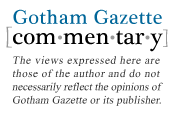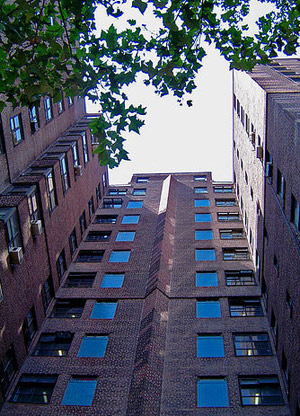Can Private Methods Save Public Housing?
Tino Hernandez, who recently resigned after seven years as chairman of the New York City Housing Authority, was a low-key figure who competently steered the authority through Bush administration cuts designed to kill public housing. While Hernandez may have been a quiet leader, and left under a cloud of bad press about elevators, his impact on the authority's direction was significant. Under his tenure NYCHA administrators initiated wide-ranging management reform -- adopting some private sector methods and emphasizing non-governmental sources of revenue -- in the hope of saving this massive housing system.

Tenants, employees and many housing advocates have expressed legitimate concerns about outsourcing work to private companies and rent increases, but taken as a whole this "new" direction looks a lot like the original vision of public housing. NYCHA's founders in the 1930s never intended to isolate public housing residents from market forces or private sector management. They envisioned a vast system filled with working people paying a reasonable rent for quality, moderately subsidized housing.
Public housing was also a key element in rebuilding neighborhoods to attract private investment; private contractors built the projects; and private entities often played a role in upkeep. New York's system was largely built under this model, making it dramatically different from troubled public housing in cities like Chicago and St. Louis.
Reinventing Public Housing, New York Style
From the late 1960s to the 1990s, however, politicians forced NYCHA administrators to accept a welfare state model of absurdly low rents, more welfare tenants and skyrocketing labor costs. NYCHA projects became isolated from the mainstream of New York life. New York still did better a better job managing its projects than other cities, but social problems and management challenges multiplied.
Since the mid-1990s, and mostly under Hernandez's guidance since 2001, NYCHA began to embrace the notion that public housing cannot survive in America without some market discipline and private sector participation. The hubbub over elevator outages and budget shortfalls at NYCHA has obscured not only the decent state of NYCHA housing as a whole, but also a more important shift in philosophy. Economic reality matters once again to NYCHA.
New York's new direction does not include the dramatic demolition and private redevelopment that has accompanied outright privatization of housing projects in cities such as Chicago. Nor are NYCHA's projects likely to be sold to tenants or investors. The 178,000 apartments managed by NYCHA will remain as comparatively affordable housing into the future. Declining subsidies, and an ideological preference for private sector approaches, have nevertheless inspired so many distinct reforms that the system as a whole is quite different from what it was just a decade ago.
What does market-based reality in New York's public housing look like? It starts with moving toward realistic rents. Rents became so out of line with operating costs that they threatened to sink the authority in the long term. Even after recent increases, average apartment rents are still only $378 per month.
At long last the top earners in the current tenant population (about 25 percent of tenants) pay more and will pay more in the future. A "working family preference," which favors working families in the admissions process, has so improved the mix in New York's projects that the authority can now turn to these families to make up, in part, for declining subsidies. In 2008, for instance, NYCHA collected $788 million in tenant rent and only $803 million in federal public housing subsidies. This robust collection is possible because, contrary to popular perception, only 12 percent of current NYCHA families subsist on welfare and over 45 percent are working families. (The other 43 percent are seniors and the disabled.)
NYCHA isn't going upscale overnight. By federal law, rents remain capped at 30 percent of income; average family income is still only $22,000; the state government is increasing payments for welfare families; and the federal Department of Housing and Urban Development has approved the use of Section 8 vouchers in some projects.
The working family preference, however, is likely to tilt the balance from the very poor. New York is moving from a model of welfare state public housing, where public housing serves the neediest as a government social program, back to its roots as a system of partly self-supporting affordable housing for the city's working class. This shift certainly raises the question of what is to be done with the very poor, but we know for certain they should not be concentrated in NYCHA projects.
Changes in the Projects
Tenants paying more rent will also demand a level of service equivalent to that found in private housing. Some already are. The $107 million plan to replace and maintain elevators may reflect the rising expectations of residents. Working families also can create a culture of achievement and decorum. Respect for buildings and equipment, more common in private housing where tenants understand the relationship between vandalism and rental costs, will hopefully reduce the burden on NYCHA budgets and staff in the long run.
Another sign of the declining public character of public housing is the closing of many community centers and shifting of community programs (for youth, seniors, the unemployed, etc.) from NYCHA's purview. The federal government never provided much support for this mission, leaving NYCHA to shift funds around to cover its community operations.
Those days are coming to an end. Many community centers and programs will, in 2009, either close or be signed over to city agencies and non-profit organizations; hundreds of positions are being eliminated to save millions annually. The long-term effects of these changes will depend entirely on the degree to which already strapped public and private agencies pick up the slack. NYCHA's retreat from running social programs has been widely criticized but it is in line with the original intent of NYCHA's founders who welcomed nonprofits into public housing and never intended to run social service or community programs from the top down.
Private sector approaches are evident in labor policies generally. Private contractors have always been a key element of NYCHA's management style, but the scale is changing. The number of direct, public housing employees has shrunk dramatically over the last few years. Today 12,400 staff members maintain a system of housing for over 400,000 people, down from a high of 15,000 employees. NYCHA administrators have largely preserved field staff on the grounds (janitors, elevator repairmen, etc.), but management offices at many adjoining developments have been merged and private sector contracting is on the rise. Private contracting now includes much construction and renovation work, technology upgrades, and even legal services. Many of the small, scatter site developments are entirely managed by private contractors.
Private employees are more economical in the long run than unionized employees who receive high wages and generous benefits regardless of financial conditions. Unionized staff is good for the city's financial health, but only made sense in the context of strong subsidies. No one knows, however, if fewer people and further innovation will yield better maintenance in the long term. New York sorely needs a non-partisan Straphangers style evaluation system that can make sure NYCHA lives up to its stated standards. (is a sample of what this might look like).
A promising aspect of the private sector management model is the introduction of a centralized call center for tenant complaints staffed by NYCHA employees. This service has proved extraordinarily popular with tenants and gives reason to hope that more can be done with less.
Wide Open Spaces
The disposition of NYCHA's vast land rights is the least advanced but potentially most dramatic change initiated during Hernandez's tenure. This process also harks back to NYCHA's founding years when public housing was a key force for leveraging private investment in tenement slums. Many of NYCHA's traditional public housing complexes are mostly open space, and this land has been underutilized, for decades. The buildings of Riis Houses on the Lower East Side, for instance, cover only 20 percent of the land. Middle-income and affordable housing, built through a partnership of different housing agencies, already is under construction on the grounds of some developments. Pressure is also being felt to sell air rights, valued in the millions, to brighten NYCHA's balance sheets.
The upside of this process, should it gain traction, will be more revenue for renovation and daily operations as well as greater social and architectural variety. New construction, if creatively considered, offers the opportunity to knit NYCHA towers back into the city as a whole.
What could public housing look like in the long term if these methods are successful? Housing projects still will be affordable compared to their neighbors, but not as cheap as they are today. More working and lower middle-class families, and new developments on NYCHA land, will help break up remaining concentrations of poverty. Standards of maintenance and upkeep will be higher in spite of fewer employees. Non-profits and city agencies will run great community centers. Far less subsidy will be demanded, and NYCHA will balance its budget. Such a system would, in fact, be the realization of the founders' original intent.
Less rosy scenarios are quite possible, and questions of equity remain for both tenants and workers, but applying private-sector approaches in New York could actually preserve public housing. If it does, this will, in no small measure, be part of Tino Hernandez's legacy.
Nicholas Dagen Bloom is an associate professor at New York Institute of Technology and author of "Public Housing That Worked: New York in the Twentieth Century."
Working for a Greener Harlem

At 7 a.m. on Martin Luther King Day, 1988, the founders of the soon to be formed West Harlem Environmental Action (WEACT) donned gas masks and placards, and held up traffic on the West Side Highway in front of the North River Sewage Treatment Plant. For the two years since it opened, the sewage plant had plagued the Harlem community with foul odors and noxious emissions that residents blamed for their respiratory problems.
Twenty years later, WEACT has 17 staff members dedicated to mitigating the disproportionate environmental burdens that Harlem residents bear and, more recently, to fighting for climate justice. Since PlaNYC2030's launch in 2007, WEACT has lobbied to make sure the proposal's benefits extend all the way uptown. Now it sees the effort as paying off in a variety of ways that could improve public health and the environment in Upper Manhattan.
A History of Activism
WEACT's fight against the sewage treatment plant did not end with a demonstration. Four years later, the organization sued the Department of Environmental Protection for operating that plant as a public and private nuisance. After six years of litigation, the city settled the North River Sewage Treatment Plant suit and established a $1.1 million fund to address community concerns. The fund enabled WEACT to hire three full-time staff members and allowed the group to ensure that the city completed its $55 million renovation of the plant.
WEACT filed a complaint against the Metropolitan Transportation Authority for locating a disproportionate number of its bus depots and other facilities in northern Manhattan. The area still houses six out of the city's seven diesel bus depots. In 2004, the Federal Transportation Authority validated the MTA complaint. Also that year, WEACT successfully blocked the reopening of the 135th Street marine waste transfer station on the grounds that the station would bring even more pollution into an area that already had more than its fair share. All the while, WEACT staff continued to educate Harlem residents about the environmental issues that threaten their health and well being.

A decade ago, the organization began lobbying the MTA and the state to use cleaner fuels and added global warming to its agenda by joining national and local climate justice initiatives such as the Environmental Justice Climate Change Initiative, and the Campaign for New York's Future. "The most vulnerable communities even in the richest nations will be those who are first and worst impacted," explained WEACT deputy director Cecil Corbin Mark. "So we have begun in the last three years to work on increasing our community's awareness of the health impacts of climate change and to have them understand some of the policy issues that are involved."
As the effects of climate change become increasingly apparent, WEACT has geared its local efforts toward adaptation. For instance, Corbin Mark said that WEACT is addressing questions such as, "How does our community adapt to this? If we know that climate change is coming, how do we as communities become prepared to deal with that reality? Part of it is reducing our carbon footprint, reducing our impact on this moving train of global warming."
That, of course, is also one of the key goals of PlaNYC2030.
Sustainability in Harlem
In 2006 Mayor Michael Bloomberg invited WEACT founder, Peggy Shepherd to participate on his Sustainability Advisory Board and help draft PlaNYC2030. Shepherd and her organization saw a golden opportunity to ensure that the plan addressed justice issues.
One example is the city's Million Trees Program. According to Corbin Mark, WEACT has "been very focused on ... trying to make sure we get as many of those million trees as possible planted in northern Manhattan. ... The more trees we can get planted – and hopefully they grow quick and fast and big and tall -- the more we are able to offset the heat effect that we have going."
Another of PlaNYC's strategies to offset the "urban heat island effect" is to encourage green roofs, roofs that are at least partially covered with vegetation to absorb storm water, reflect sunlight and insulate the building. To launch that effort, WEACT is raising funds from private donors for its "From Tar Beach to Green Roofs" initiative to create green roofs all along 125th Street. It plans to start with some of the public buildings, including two schools where students will be involved in the design process.
WEACT also intends to capitalize on PlaNYC2030's attention to greening buildings through retrofitting. Here again, the plan offers the group an opportunity to further long-standing goals of educating Harlemites about indoor toxins such as lead paint, mold and rat poison.
"I think that is a real frontier for us as we think about healthier homes and a better housing stock for our community," said Corbin Mark, "One of the things we constantly deal with in northern Manhattan is landlords using dirty grades of oil" in their boilers. Accordingly, WEACT is working to fund programs that will help landlords not only to retrofit their boilers to require less oil, but also to use cleaner, more renewable energy sources.
Finally, according to PlaNYC2030, no New Yorker should live more than a "10 minute walk from a park." WEACT would like to see those new green spaces in Harlem serve multiple purposes. The organization wants to green local school yards with vegetable gardens. The gardens would be accessible to community members, and would involve students in growing their own food, while teaching them about healthy food choices.
Thus, this initiative addresses green space as well as childhood obesity rates and diabetes. In 2007, the East and Central Harlem District Public Health Office reported that more than one in four children in the area's Head Start programs and public elementary schools are obese, and the New York City Department of Health and Mental Hygiene estimates that adolescents account for 45 percent of Harlem's diabetes cases.
Meeting Community Needs
If PlaNYC2030 is to improve the ecological and social environment in Harlem, the community will have to work with city officials. This can take effort on both sides.
As an example, Corbin Mark cites the city's climate change training session in East Harlem last spring. "The mayor's staff reached out to us and worked with us to develop something," Corbin Mark said. But Corbin Mark advised city officials that their one-size-fits-all approach would not work. Rather, the training had to be culturally and geographically sensitive.
"We literally had them redo what they thought was their very glorious standard training piece," Corbin Mark recalled. "I said â€no, maps need to be focused on East Harlem; pictures need to be focused on East Harlem; concepts need to be focused on what does this mean to East Harlem.'" To Corbin Mark's pleasure, the city was receptive. "In the process I think they began to really understand what it means to think about these concepts from a local perch, a local perspective," he said.
But Corbin Mark also recognizes that he and his colleagues will have to maintain their vigilance. "You've got this blueprint out here [in PlaNYC 2030] and either some of these initiatives die on the vine, or they get implemented from a very top down kind of approach," he said. "We don't want put in all this thinking and labor and effort to make this blueprint, and then have the plan not come to our communities."
Melissa Checker is assistant professor of urban studies at Queens College, City University of New York. She is the author of Polluted Promises: Environmental Racism and the Search for Justice in a Southern Town,
Â
After the Meltdown: New York's Future

It is no exaggeration to say the short-term economic outlook is cloudier today than at almost any time in decades. The recession is already worse than anticipated. It is worldwide, it has structural roots as well as cyclical ones, and while it emanates from the financial sector, it reflects fundamental imbalances among consumers and in the broader economy.
So far, New York City has seen relatively modest job declines concentrated in finance and a small number of other areas. The city and its immediate suburbs have lagged the nation in terms of aggregate job losses that have been taking place for nearly a year. However, most regional economists expect the city to catch up very quickly, and by the middle of next year, the pace of our job losses likely will exceed the national average.
The coming months will pose real hardships for many New Yorkers, particularly low- and moderate-income families. Unemployment will rise, public services will suffer, and the mortgage foreclosure problem will undercut struggling neighborhoods. Despite the difficult times ahead, though, with the right government actions, New York City has a good chance of emerging from this turmoil in fairly good shape.
The Short-Term Outlook
Current forecasts call for New York City to lose 150,000 to 175,000 jobs by the end of next year. This would be about a 5 percent drop. That's less than during the downturn earlier this decade when we lost 240,000 jobs, and much less than in the downturn of the late 1980s to early 1990s that was much worse in the New York region than in the nation as a whole. New York City lost 10 percent of our jobs then. Of course, no one knows how steep or long the current downturn will be. Only four or five months ago, most forecasts predicted job losses about half of what they are now.
Through September, the city's finance sector lost a net of about 10,000 jobs, a little over 2 percent of the total. Following the financial market meltdown in the last half of September, not only did credit markets freeze up but the bottom dropped out of consumer confidence and spending. New York is feeling the effects of a recession that has spread across the globe.
New York's job losses appear to be accelerating. Finance sector employment will fall sharply - it could lose as many as 50,000 or 60,000 jobs in New York City, 10 percent to12 percent of the total. This will be accompanied by a substantial decline for many of the businesses that fill so many of Manhattan's buildings: professional and business services, corporate headquarters, media and technology. Hospitality and retail will suffer. And construction activity over the next two years will decline by 20 percent or more. With its concentration of financial and other export-oriented businesses, Manhattan's job base will contract much more than the employment levels in the other boroughs.
After the Recession
Economists know even less about what the recovery will look like than what we know about how bad the downturn will become. We expect to see a profound structural shift within the finance sector and in the relation of the finance sector to the broader economy and to government. This likely will mean that, for at least the next few years, the finance sector will not be as large as it was in 2007. Its presence in New York City could permanently shrink by 10 percent, if not more.
For the intermediate- and longer-term, though, New York's prospects remain fairly bright. We are in a much better position than we thought we were right after 9/11 when many feared that large commercial centers like New York City would no longer be viable in a time of terrorist attacks. Now, we face an energy-constrained world where New York City's overall energy efficiency and reliance on the most extensive mass transit system in the U.S. is a great asset.
Our dense concentration of business gives us a big leg up in terms of the productivity and profitability of many sectors - professional services, media, information technology, design and engineering. In most of these areas, the "value added" (the net dollar value created by business) per employee far outpaces the national average. Our cultural offerings surpass most cities in the world. The quality of life in the city has steadily improved.
New York City's many attributes are recognized in the 2008 ranking by Foreign Policy magazine in their Global Cities Index. New York City ranks as the Number 1 City To Do Business In out of 60 global cities. Of the five factors considered, New York ranked highest in business activity and human capital, second in political engagement, third in cultural exchange and fourth in information exchange. If you're worried about New York City's future in a world where we've seen "The End of Wall Street as We Know It," post those rankings next to your desk. Our recovery may be fitful, but New York City will continue to be a magnet for top entrepreneurial and creative talent the world over.
Government's Role
As many assets as the city has, New York's economic future depends heavily on effective national policies to foster genuine economic recovery. What happens in Washington, D.C. over the next several months is probably more central to the well being of New York City than at any other time since the days of President Franklin D. Roosevelt. Unprecedented actions have been taken, and unprecedented taxpayer resources have been committed to stabilizing the financial sector. It hasn't been stabilized yet, but the focus is there and the resources are at hand.
At least two other things also need to be done.
First, we have to stabilize the housing sector. It's paralyzed now. Prices have declined by 25 percent and are headed further down. We have to stem the flood of foreclosures and put a floor under housing prices. Millions of mortgages have to be renegotiated, losses have to be taken, bundles of mortgages have to be unbundled.
Second, the government must craft a robust macroeconomic recovery program to stem the current downward spiral. Usually, rising home sales, new construction and the related purchase of new appliances and furnishings pull the economy out of a downturn. Given the deep slump housing is in, that is not likely this time. The economy needs a big stimulus to turn the economy around and to substitute for the push a recovering housing sector normally provides.
To accomplish this, our leaders need to confront the forces that will say we can't let the federal deficit get any larger. We need to listen to John Maynard Keynes and not Pete Peterson. (Peterson, a prominent financier, is a leading advocate of the position that a looming federal deficit is the biggest barrier to long-term prosperity.) An effective economic recovery program might take 3 percent, 4 percent or 5 percent of Gross Domestic Product ($400 billion to $700 billion). Even so, that is far less than we have poured into the financial markets, and unless we're willing to make this additional investment, the money we've directed to saving the financial markets won't even be effective.
New York City's recovery won't get underway until we have a national program in place to deal with the other roadblocks remaining from the bursting of the housing and derivatives bubbles and to restore consumer confidence and spending.
This national economic recovery program needs to include:
-- A better targeted stimulus, including state fiscal and Medicaid relief, extended unemployment benefits, and increased aid to low-income populations;
-- A robust program to invest in infrastructure that funds ready-to-go state and local government projects (schools, sewers, roads, transit systems, etc.) and includes a major investment in green jobs to promote residential and commercial building retrofits and alternative energy development.
-- A universal health insurance program that covers the uninsured, finances health care in a sustainable way and helps small businesses provide affordable coverage to their employees.
We also need policies at the local, state and regional level to support, not undercut, these initiatives. We have to make sure we don't reinforce the downward economic spiral with damaging state and city budget cuts. Hopefully, we will come out of this downturn with an economy whose prosperity does not depend on debt and whose growth is more energy-efficient and sustainable. Sustainability means lessening our severe income disparities as well as achieving a better long-term environmental balance. If we have the right national policies, New York City will do well.
(This column is based on remarks Parrott gave at a Nov. 12 economic forum sponsored by McGraw-Hill and Zetlin & DeChiara LLP in association with the New York Building Congress and other organizations.)
James Parrott is deputy director and chief economist of the Fiscal Policy Institute (www.fiscalpolicy.org). He has been studying and writing about the New York economy since he landed in New York City a quarter century ago.Â





